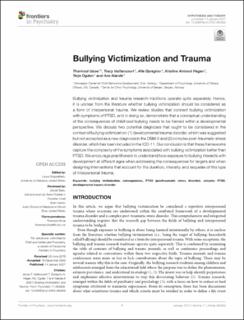| dc.contributor.author | Idsoe, Thormod | |
| dc.contributor.author | Vaillancourt, T | |
| dc.contributor.author | Dyregrov, Atle | |
| dc.contributor.author | Hagen, Kristine Amlund | |
| dc.contributor.author | Ogden, Terje | |
| dc.contributor.author | Nærde, Ane | |
| dc.date.accessioned | 2021-05-04T14:57:21Z | |
| dc.date.available | 2021-05-04T14:57:21Z | |
| dc.date.created | 2021-02-03T13:39:33Z | |
| dc.date.issued | 2021 | |
| dc.identifier.issn | 1664-0640 | |
| dc.identifier.uri | https://hdl.handle.net/11250/2753561 | |
| dc.description.abstract | Bullying victimization and trauma research traditions operate quite separately. Hence, it is unclear from the literature whether bullying victimization should be considered as a form of interpersonal trauma. We review studies that connect bullying victimization with symptoms of PTSD, and in doing so, demonstrate that a conceptual understanding of the consequences of childhood bullying needs to be framed within a developmental perspective. We discuss two potential diagnoses that ought to be considered in the context of bullying victimization: (1) developmental trauma disorder, which was suggested but not accepted as a new diagnosis in the DSM-5 and (2) complex post-traumatic stress disorder, which has been included in the ICD-11. Our conclusion is that these frameworks capture the complexity of the symptoms associated with bullying victimization better than PTSD. We encourage practitioners to understand how exposure to bullying interacts with development at different ages when addressing the consequences for targets and when designing interventions that account for the duration, intensity, and sequelae of this type of interpersonal trauma. | en_US |
| dc.language.iso | eng | en_US |
| dc.publisher | Frontiers | en_US |
| dc.rights | Navngivelse 4.0 Internasjonal | * |
| dc.rights.uri | http://creativecommons.org/licenses/by/4.0/deed.no | * |
| dc.title | Bullying Victimization and Trauma | en_US |
| dc.type | Journal article | en_US |
| dc.type | Peer reviewed | en_US |
| dc.description.version | publishedVersion | en_US |
| dc.rights.holder | Copyright 2021 Idsoe, Vaillancourt, Dyregrov, Hagen, Ogden and Nærde. | en_US |
| dc.source.articlenumber | 480353 | en_US |
| cristin.ispublished | true | |
| cristin.fulltext | original | |
| cristin.qualitycode | 1 | |
| dc.identifier.doi | https://doi.org/10.3389/fpsyt.2020.480353 | |
| dc.identifier.cristin | 1886338 | |
| dc.source.journal | Frontiers in Psychiatry | en_US |
| dc.source.40 | 11 | |
| dc.identifier.citation | Frontiers in Psychiatry. 2021, 11, 480353 | en_US |
| dc.source.volume | 11 | en_US |

